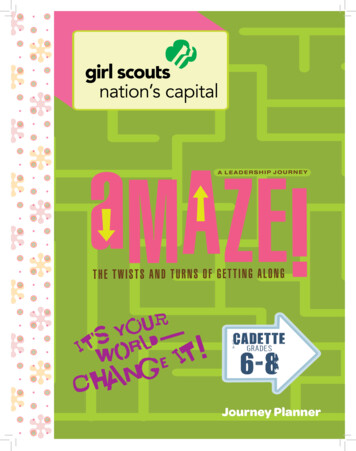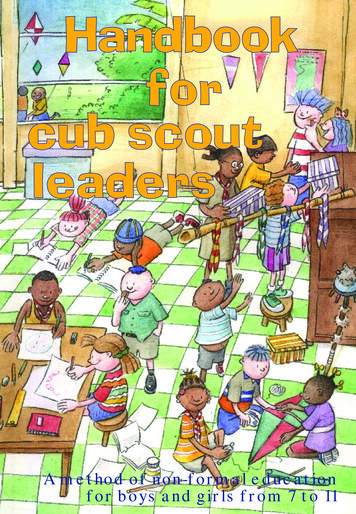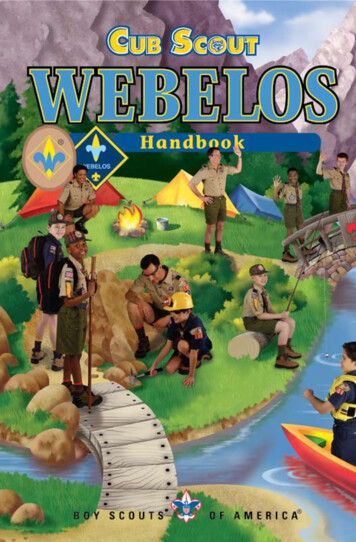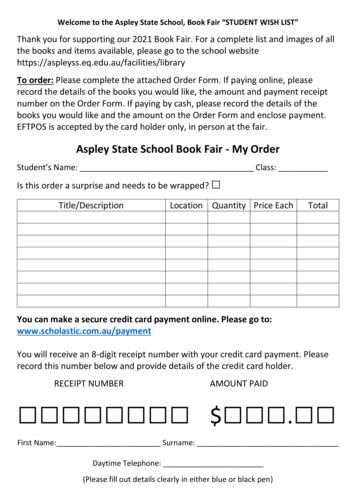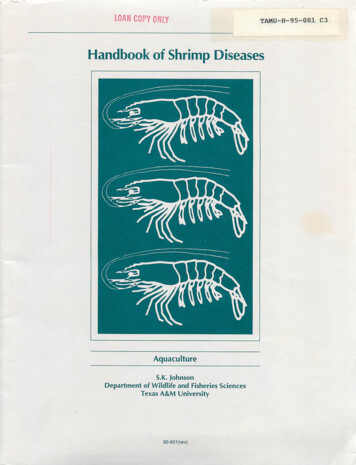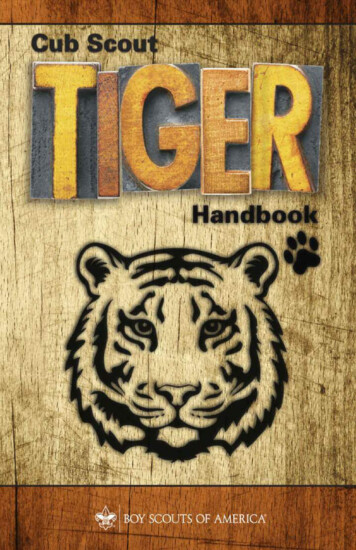
Transcription
Cub Scout Tiger HandbookBOY S COUTS OF AMERICA*
Table of ContentsTIGER PARENT INTRODUCTIONUsing This HandbookYour Son, Scouting, and YouThe Purposes of Cub ScoutingCub Scout DenCub Scout Pack LeadershipYour Tiger’s AdvancementDo Your BestTiger BadgeScouting and Duty to GodWELCOME, TIGER!Cub ScoutingYour Tiger LeadersYour Tiger Den and Den M eetingsYour Pack M eetingsYour Tiger UniformCharacter CompassThe Outdoor CodeLeave No Trace Principles for KidsYOUR FIRS T RANK—BOBCAT!THE TIGER ADVENTURES AND REQUIREMENTS
Tiger Required AdventuresBackyard JungleGames Tigers PlayM y Family’s Duty to GodTeam TigerTiger BitesTigers in the WildTiger Elective AdventuresCuriosity, Intrigue, and M agical M ysteriesEarning Your StripesFamily StoriesFloats and BoatsGood KnightsRolling TigersSky Is the LimitStories in ShapesTiger-iffic!Tiger: Safe and SmartTiger TagTiger TalesTiger TheaterSpecial Awards You Can EarnBobcat Trail
Tiger Adventure TrackingGet Set for the Wolf Adventures!
Your son is growing up fast. Just look at how quickly he outgrows his clothes! As he grows, you canhelp him develop confidence in himself and respect for others. And you will both have fun doing it.The Cub Scouting adventure for him begins with Tiger—a program of exciting indoor and outdooractivities just right for a boy who is in first grade and/or is 7 years old. You are there with him as hissupport and guide, but you don’t do things for him. He will learn by doing things himself. And as he learnsand grows, your relationship with him will grow, too.Today your son is a Tiger, but soon he will graduate into a Wolf den. Later, he’ll work to achieve theBear rank, followed by the Webelos and Arrow of Light ranks. This will prepare him for more adventure asa Boy Scout and the opportunity to earn Scouting’s highest rank—Eagle Scout.Using This HandbookYour Tiger and you, his adult partner, are a team. This handbook is for both of you. Some of what is init, such as this parent information section, is for you, the adult. However, it is our hope that you will readthe adventures along with your Tiger and help him to achieve them!Your Son, Scouting, and YouAs a parent or caring adult, you want your Tiger to grow up to be self-reliant and dependable, worthyand caring. Scouting has these same goals in mind for him.The mission of the Boy S couts of America is to prepare young people to make ethical andmoral choices over their lifetimes by instilling in them the values of the S cout Oath and S coutLaw.
The S cout Oath and the S cout Law are defined on pages 18 through 21 in the Bobcatrequirements.Since 1910, the Boy Scouts of America has been weaving lifetime values into fun, developmentalactivities. These activities are designed to help families teach their sons how to make good decisionsthroughout their lives and give them confidence as they become the adult leaders of tomorrow.In a society where your son is often taught that winning is everything, Cub Scouting teaches him toDO HIS BEST, to help others and to try to live his life according to the Scout Oath and the Scout Law. If aCub Scout has done his best to satisfy a requirement, then he has met the standard for advancement in CubScouts. It is up to his parent and den leader to gauge whether he has offered his best effort.The Purposes of Cub ScoutingCub Scouting is a year-round family-oriented part of the BSA program designed for boys who are infirst through fifth grades (or are 7, 8, 9, and 10 years old). Parents, leaders, and organizations work togetherto achieve the Purposes of Cub Scouting.1. Character Development2. Spiritual Growth3. Good Citizenship4. Sportsmanship and Fitness5. Family Understanding6. Respectful Relationships7. Personal Achievement8. Friendly Service9. Fun and Adventure10. Preparation for Boy Scouts
Cub Scout DenAs a Tiger, your son will be part of a group of boys his own age called a den. With his den, he can buildconfidence and self-esteem and earn recognition. He will also gain a sense of personal achievement from thenew skills he learns.Each den meeting and den activity is led by a den leader and an adult partner of one of the Tigers. Anadult partner can be a parent, relative, or friend who is at least 18 years old. The adult partner attends allden meetings, pack meetings, outings, and activities with the Tiger, and may register as an adult leader in thepack. Each adult partner takes a turn working with the den leader to plan and lead a den meeting and/oractivity. We called this S hared Leadership for the Tiger dens.Cub Scout Pack LeadershipYour Tiger is also a member of a Cub Scout pack. M ost packs are made up of several dens that gathermonthly at a pack meeting. The meeting usually follows a suggested theme, and it’s a time for boys to berecognized for their accomplishments during the month, to perform skits and songs they have learned inden meetings, and to have fun with the entire family.Packs are led by a Cubmaster and pack committee. Like the den leaders, the Cubmaster and assistantsare volunteer leaders—usually family members of boys in the pack. The pack committee makes plans forpack meetings and activities and takes care of the “business” items that are necessary for a pack to operatesmoothly.M ost pack committees consist of family members and members of the pack’s chartered organization.This is a community organization that has applied for and received a charter from the Boy Scouts ofAmerica National Council to operate the Scouting program. The chartered organization may be a school,service club, religious group, or other group interested in youth. The chartered organization sponsors thepack, approves the leadership of the pack, provides a meeting place, and operates the pack within theguidelines and policies of that organization and the Boy Scouts of America.
You may have already signed up to be a leader or might like to help with your son’s den and pack. Visitwith the Cubmaster about the many ways you can help!Your Tiger’s AdvancementIn Scouting, advancement is the process by which a member meets certain requirements and earnsrecognition. The Tiger advancement program is a blend of activities that boys complete in their denmeetings as well as at home with their adult partner.When a boy of any age or grade joins Cub Scouting, he must earn his Bobcat badge before he can beawarded a Tiger badge, Wolf badge, Bear badge, Webelos badge, or Arrow of Light badge. Help your Tigerthrough the steps of the Bobcat rank badge. Along each step, sign “Akela’s OK.” when you feel your sonhas done his best to complete the requirement. When all of the Bobcat requirements have been completed,your boy becomes eligible to receive his Bobcat badge in a pack ceremony.As a Tiger, your son will work toward earning the Tiger rank. This rank is for those boys who are inthe first grade or are 7 years old. All the Cub Scout ranks (Tiger, Wolf, Bear, Webelos, and Arrow of Light)are tailored for a grade and the corresponding age level. To advance, Tigers work on the adventuresdescribed in this handbook, some required and some elective. As your son completes each requirement inan adventure to the best of his ability, you or another caring adult will sign the space marked “Akela’sOK.” His den leader will sign where it says, “Den Leader’s OK.” If the requirement is completed in a denmeeting, the den leader may sign both places.Akela means “good leader” and is an important part of Cub Scouting. Akela can be you, a den leader, ateacher, or another important adult. Scouts can track their requirements in the Tiger Adventure Trackingsection found at the back of the book. As boys advance, they earn adventure loops and pins to mark theirprogress. These items will be presented to them during a ceremony at a pack or den meeting. It isimportant for boys to be recognized for the good work they do!
Do Your BestYour Tiger can keep track of his adventures using the Tiger Adventure Tracking on page 277 of thishandbook. This provides encouragement and helps him see his progress toward the Tiger rank. Wheneverpossible, adventure requirements are written in a way that allows them to be customized for each boy andden. Boys are never “tested” or placed in a position where they may not be successful. If a Cub Scout hasparticipated and done his best to satisfy a requirement, then he has met the standard for advancement inCub Scouts. It is up to his parent and den leader to gauge whether he has offered his best effort.If a Tiger is unable to participate in a den or pack activity due to an illness or conflict, you may workwith him to complete the requirements to the best of his ability, but please make every effort to help himattend each meeting so he can get the full benefit of the Cub Scouting program.If your Tiger has an intellectual or physical disability that prevents him from attempting a requirement,talk to your den leader and Cubmaster about finding an alternative.Tiger BadgeThe Tiger badge is awarded when boys have completed the following:1. Complete each of the following Tiger required adventures with your den or family:
2. Complete one Tiger elective adventure of your den or family’s choosing.3. With your parent or adult partner, complete the exercises in the pamphlet How to Protect YourChildren From Child Abuse: A Parent’s Guide, and earn the Cyber Chip award for your age.**If your family does not have Internet access at home AND you do not have ready Internet access atschool or another public place or via a mobile device, the Cyber Chip portion of this requirement may bewaived by your parent or guardian.Family participation is an integral part of the advancement process, and there are many chances to joinin activities that are age-appropriate for your child. You may sign the “Akela’s OK” in his handbook eachtime he finishes a requirement, and you should always notify the den leader when a requirement iscompleted at home.The Tiger badge is presented during a special ceremony at a pack meeting to each boy’s parent orguardian, who in turn presents it to the Scout. The badge is worn on the left uniform pocket. (See page 12or inside the back cover.)
Scouting and Duty to GodThe Boy Scouts of America has always held steadfastly to the principle, embodied in the Scout Oath,that a Scout has a duty to God. The BSA does not promote any specific religion, and has always embracedall faiths. We do encourage youth members and their families to be active in their own faith, in keeping withthe BSA’s Declaration of Religious Principle.It naturally follows that the leadership for your son’s spiritual development, both within and outsideCub Scouting, must come primarily from your home and your family’s religious leaders. Your son will lookto you as his example of how to learn and perform his duty to God.The adventures related to duty to God in each rank of the Cub Scouting program provide support, andeach boy has the opportunity to earn the religious emblem of his faith. The emblem is created andpresented by your son’s religious group. M ost of the world’s religions have an emblem of their faith.However, alternative requirements are available for boys whose faith institutions do not have an emblem orwhose families are not affiliated with an organized religious group.In addition, the staff at your BSA local council service center should be able to help. M any localcouncils and districts offer organized opportunities for Scouts to earn their religious emblems while meetingand sharing fellowship with other Scouts of their faith.You can also find information on the Internet at www.praypub.org orwww.scouting.org/filestore/pdf/512-879 WB.pdf.
(For you and your Tiger to read together)Welcome to a fun and exciting year of Cub Scouting, Tiger! As a Tiger, you will be with other Tigers ina den. You will explore the world around you as you go on adventures. These adventures will teach you thefun and excitement of being a Tiger Scout. You will play games, make fun things, learn about wildlife, spendlots of time outside, and best of all HAVE FUN! You will even earn awards while you are having all thisFUN!Cub ScoutingDo you know how many years Cub Scouting has been around? Cub Scouting began in 1930, whichmeans it is now more than 80 years old. Can you imagine how many boys have been Cub Scouts in allthose years? If you said “tens of millions,” you would be right!Lord Baden-Powell founded Scouting over 100 years ago. Then younger boys also wanted to beScouts. It looked like fun and adventure! Baden-Powell and others listened to the boys and helped to createCub Scouting.Baden-Powell really liked the stories in The Jungle Book by Rudyard Kipling, and he thought many ofthe characters were fun and playful, just like Cub Scouts. He also knew it was important for the boys tohave a wise leader like Akela (Ah-KAY-la), the wolf. Akela lets M owgli (M O-glee), the boy, join the wolfpack. M aybe you also know about Baloo the bear, who helps teach M owgli the laws of the jungle so hecan live among the animals. To this day, we have names like Akela and Baloo, and words like den and pack,in Cub Scouting. That’s our way of remembering how Cub Scouting began with The Jungle Book.
Your Tiger LeadersYou have several people who you can call “Akela.” These include the den leader, the assistant denleader, and your adult partner. Akela can be anyone who is older than you and a wise teacher, just likeAkela in The Jungle Book. These leaders help you to learn new things, and they can even help you findnew ways to use what you have already learned. Akela will also sign your adventure requirements in thehandbook when you complete them.Did you know you can also help lead your den by becoming a denner? The denner is a Scout usuallychosen by the members of his den to help the den leader and den chief at meetings and outings, and servesfor about one to two months. If you’re elected to be the denner, do your best!Your Tiger Den and Den MeetingsBeing a Tiger in the Boy Scouts of America means that you belong to a den of boys who are Tigers justlike you! These boys are in the same grade or are the same age as you. You all come together with yourleaders and adult partners in “den meetings” a few times a month. In these meetings you will work on theTiger adventures, earning awards, playing games, and making fun things with the rest of the den. You andyour adult partner will have the chance to help the den leader and be in charge of one of these meetings.Your Pack MeetingsYou, your family, and your den also go to a monthly pack meeting. This is a meeting for all the boys inall the dens in the pack to get together at the same time. It’s a chance to tell others about the hard workyour den has done on the adventure that month, and also a time for awards and seeing what other Scouts inthe pack are doing, at all different rank levels.
Your Tiger UniformYour uniform is an important part of being a Cub Scout. Wearing it lets people know that you belongto a Tiger den and a Cub Scout pack and, most important, you belong to the Boy Scouts of America! Youshould wear the uniform to den meetings, pack meetings, and any special activities you participate in as aTiger.The official uniform for Cub Scouts includes blue Cub Scout pants or shorts and shirt with insignia foryour rank. Each rank has its own neckerchief and slide in the rank colors and a belt buckle to be worn withthe blue Cub Scout belt. Tiger Scouts can also wear an official navy-blue cap with an orange front panel andTiger emblem.
When you wear the full Cub Scout uniform, it shows you are a member of the team!The pictures at left show you where to put the Tiger Scout insignia on the sleeves and pockets of youruniform.
You might receive an emblem for participating in day camp or a council popcorn sale. This is anexample of “temporary insignia” and should be worn centered on the right pocket.The denner wears gold shoulder cords suspended from the left shoulder of his uniform. The cords areremoved when his time as the denner ends.Character CompassAs you work on your Tiger adventures in your Tiger Handbook, you will notice this symbol:A compass is a tool that guides a person from place to place. Character is how we act, and it guides ourentire lives. This compass will be your guide to one or more of the 12 points of the Scout Law. Every timeyou check the compass, it will remind you of how the activities in each adventure are related to the ScoutLaw. This may also help you think about how the points of the Scout Law guide our way in Cub Scoutingand in daily life. Those points are all different, and each one is a treasure for you to find.
The Outdoor CodeM uch of Scouting, including Cub Scouting, happens outside. For more than 60 years, the OutdoorCode has been a guide for Scouts in the outdoors. Remember to do your best by showing respect for theoutdoors and by learning and upholding the Outdoor Code.The Outdoor CodeAs an American, I will do my best to—Be clean in my outdoor manners,Be careful with fire,Be considerate in the outdoors, andBe conservation-minded.Being clean in our outdoor manners, careful with fire, and considerate means we can enjoy the outdoorsin ways that do no harm to the environment. Being conservation-minded encourages the protection andthoughtful use of natural resources and doing your part to improve the condition of the land and theenvironment.As a Cub Scout, you will learn to use the Leave No Trace Principles for Kids to help you take care ofan area where you hike or camp.Leave No Trace Principles For Kids*1. Know Before You Go. Find out about the place you’re going to camp ahead of time. Are thererules you need to know about? Are any activities against the rules? Is water available? Do youneed to bring anything special?
2. Choose the Right Path. Always walk on trails, even if that means getting your boots muddy.Don’t take shortcuts. Set up tents in marked camping areas.3. Trash Your Trash. Use bathroom facilities when available. Follow campground rules for handlingdishwater. Pack out all your trash unless the campground has trash pickup.4. Leave What You Find. Leave any natural treasures where you find them so other campers canenjoy them, too. If you want a souvenir of your campout, take a picture. A good saying toremember is “Leave nothing but footprints, take nothing but pictures, kill nothing but time.”5. Be Careful With Fire. Cook on a camp stove or grill whenever possible. It’s easier and lessmessy than cooking over an open fire. Only build fires in designated fire rings. Always havesomeone keep an eye on your fire until it is dead out.6. Respect Wildlife. Travel quietly and give animals enough space that you don’t disturb them.Getting too close to an animal can potentially hurt the animal and you. Take pictures from a safedistance. You’re visiting the animal’s home, so be considerate.7. Be Kind to Other Visitors. Be respectful of other visitors by keeping noise down and notentering other groups’ campsites without permission. Be polite to other people you meet. Givethem the respect you expect from them.To help you remember the Outdoor Code and the Leave No Trace Principles for Kids, you can findthem in the back of your handbook.*The member-driven Leave No Trace Center for Outdoor Ethics teaches people how to enjoy the outdoorsresponsibly. This copyrighted information has been reprinted with permission from the Leave No TraceCenter for Outdoor Ethics: www.LNT.org.
Let’s start out on the trail of your Cub Scouting adventures by learning what it takes to become aBobcat. One of the most important steps is to understand that all members of the Boy Scouts of Americabelieve in, live by, and often repeat the Scout Oath and the Scout Law. We learn those words and believe inthem as a way to live our lives and be good members of our families, our communities, and the Boy Scoutsof America.With your adult partner, read through the Bobcat requirements and practice several times what youhave learned. When you and your adult partner think that you are ready, share what you’ve learned withyour family, your den leader, and with your den at a pack meeting. Then give yourself a pat on the backand congratulate yourself on earning your Bobcat badge!Bobcat Requirements1. Learn and say the S cout Oath, with help if needed.2. Learn and say the S cout Law, with help if needed.3. S how the Cub S cout sign. Tell what it means.4. S how the Cub S cout handshake. Tell what it means.5. S ay the Cub S cout motto. Tell what it means.6. S how the Cub S cout salute. Tell what it means.7. With your parent or guardian, complete the exercises in the pamphlet How to Protect YourChildren From Child Abuse: A Parent’s Guide.
1 Learn and say the S cout Oath, with help if needed.Scout OathOn my honor I will do my bestTo do my duty to God and my countryand to obey the S cout Law;To help other people at all times;To keep myself physically strong,mentally awake, and morally straight.The Meaning of the S cout OathON MY HONOR I WILL DO MY BES TSaying “On my honor” is like saying “I promise.” It means that you will do your best to do what the ScoutOath says.The S cout Oath has three promises.
Let’s look at what they mean.TO DO MY DUTY TO GODAND MY COUNTRY AND TOOBEY THE S COUT LAWA duty is something you are expected to do. At home, you might be expected to make up your bed ortake out the trash. You also have duties to God and to your country. You do your duty to God byfollowing the teachings of your family and religious leaders. You do your duty to your country by being agood citizen and obeying the law. You also promise to live by the 12 points of the Scout Law, which aredescribed on the next page.TO HELP OTHER PEOPLE AT ALL TIM ESM any people need help. A friendly smile and a helping hand make life easier for others. By helpingother people, you are doing a Good Turn and making our world a better place.TO KEEP M YSELF PHYSICALLY STRONG, M ENTALLY AWAKE, AND M ORALLY STRAIGHTThe last part of the Scout Oath is about taking care of yourself. You stay physically strong when youeat the right foods and get plenty of exercise. You stay mentally awake when you work hard in school,learn all you can, and ask questions. You stay morally straight when you do the right thing and live yourlife with honesty.2 Learn and say the S cout Law, with help if needed.S cout LawA S cout is trustworthy, loyal, helpful, friendly, courteous, kind, obedient, cheerful, thrifty, brave,clean, and reverent.
The Meaning of the S cout LawThe Scout Law has 12 points. Each is a goal for every Scout. He does his best to live up to the Lawevery day. It is not always easy to do, but a Scout always tries.
3 S how the Cub S cout sign. Tell what it means.M ake the sign with your right hand. Hold your arm straight up. The two raised fingers stand for theScout Oath and the Scout Law. The fingers look like the sharp ears of the wolf ready to listen to Akela!Remember that Akela means “good leader” to a Cub Scout. Your mother or father or guardian is Akela. Sois your Cubmaster or your den leader. At school, your teacher is Akela.
4 S how the Cub S cout handshake. Tell what it means.When you shake hands with another Cub Scout, do this: Hold out your right hand just as you alwaysdo to shake hands. But then put your first two fingers along the inside of the other boy’s wrist. This meansthat you help each other to remember and obey the Scout Oath and Scout Law.
5 S ay the Cub S cout motto. Tell what it means.The Cub S cout motto is “Do Your Best.”A motto is a guiding principle and a rule for living. Do Your Best means trying your hardest, not just alittle bit. Do your best all the time. Do your best in school and at home. Do your best when you play agame and help your team. Do your best as you work on your rank adventures!
6 S how the Cub S cout salute. Tell what it means.Salute with your right hand. Hold your first two fingers close together. Touch your fingertips to yourcap. If you aren’t wearing a cap, touch your right eyebrow. You salute the flag to show respect to ourcountry. Always use the Cub Scout salute when you are in your Cub Scout uniform, both indoors andoutdoors. If you are not in uniform, you salute the flag by placing your right hand over your heart.7 With your parent or guardian, complete the exercises in the pamphlet How to ProtectYour Children from Child Abuse: A Parent’s Guide.If your handbook does not include the pamphlet, talk with your den leader.
Congratulations on earning your Bobcat badge! You may now continue on the trail of your Tigeradventures. Let’s take a look at what those adventures are called, what you need to do to earn your Tigerbadge, and all the fun things you will explore as a Tiger!
Tiger Rank Requirements1. Complete each of the following Tiger required adventures with your den or family:
2. Complete one Tiger elective adventure of your den or family’s choosing. (See page 29.)3. With your parent or guardian, complete the exercises in the pamphlet How to Protect Your Childrenfrom Child Abuse: A Parent’s Guide and earn the Cyber Chip award for your age.** If your family does not have Internet access at home AND you do not have ready Internet access atschool or another public place or via a mobile device, the Cyber Chip portion of this requirement may bewaived by your parent or guardian.Once you have achieved all of the Tiger rank badge requirements and your handbook has been signed,you are ready to earn your Tiger badge. Let out a big GRAND HOWL, Tiger Scout!
Tiger Elective Adventures
Tiger Required Adventures
Snapshot of AdventureM aybe you live in the city. M aybe you live in the country. Or maybe you live in between. No matterwhere you live, you will find amazing bugs, birds, and animals nearby. Some are big, and some are tiny.Sometimes they have homes we can see, like birds’ nests. Other times their homes are hidden. But they allhave a place in the world, just like you do.In this adventure, we will discover bugs, birds, and animals near you. We will build a house for our birdneighbors. And we will plant a tree or outdoor plant to make a home for other wild creatures. But first, weare going to go for the world’s shortest hike!
Requirement 1 Take a 1-foot hike. Make a list of the living things you find on your 1foot hike.With your den, an adult partner, or your family, pick an outdoor place close by. It could be rightoutside your den’s meeting place. Or it could be a park or a grassy area at your school or library. It couldeven be your own backyard. You won’t need a giant forest for this hike.You will, however, still need to be prepared. After all, you are a Cub Scout!Be sure to bring along these jungle tools:a rulera pen or a pencila notebooka piece of string that is 4 feet long or longerIf you or your family has a camera, bring that too. You might want to take photos of all the excitingthings you find.
Before you set out on this adventure, check the weather. You might need to wear clothes that will keepyou warm and dry, and you will want sunscreen to protect your skin.Now you can head out into the wild. Once you find the perfect spot, it is time to mark off a 1-footjungle.1. M ake a square that is 1 foot long on each side.2. Look closely at what is inside the square you just made. It might be small, but there is a wholeworld of activity happening in there. Do you see any of the things on these pages?3. Write down the things you find in your square. If you have a camera, you can take pictures too.You might be surprised by the number of neat things you find.Bugs
Animal or insect tracksA baby insect or a bird’s nestAn insect house or animal house
Animal foodLitterA S cout is clean. Be sure to clean up your square. If you find any garbage in yoursquare, use gloves to pick it up. Think about what to do with it. Can it be recycled?Or should you put it in a trash can?Take your notebook with you to your den meetings, and share what you found with your Tiger den.If you want to explore more, ask an adult to take you back to your square a few days later. Or you caneven visit during a different season. You might just see something new!
Requirement 2 Point out two different kinds of birds that live in your area.In this part of the adventure, you will be looking to the skies. With your adult partner, take a walk inyour neighborhood. Keep your eyes open, and look around for birds and birds’ nests. Take a notebookwith you, and write down what you find. Try to answer these questions:What color is the bird?How big is it?If you find a nest, what does it look like?What is it made out of?Birds’ nests are like our houses. Birds make nests so they will have a warm, safe place to hatch theireggs and raise their babies. The babies stay in the nest while the parents fly around to get food for them.Do you see any eggs or babies in the nest?
A S cout is kind. You can be kind to the birds by not touching their nests, their eggs,or their babies. By leaving them alone, you can help them have a safe home.What sounds do the birds make?As you can hear, birds make really interesting sounds. That is how they talk to each other. They do notuse words like we do. Can you make the same sounds they make?
Migrating birdsSome birds live in the same place all the time. Other birds live in different places at different times ofyear. For example, they might leave their homes before winter to find a warmer place. Then they returnwhen winter is over. This is called migration. Some birds fly thousands of miles when they migrate!Ask your adult partner to help you find out about birds in your area.Note to Adult PartnerHelp your Tiger learn about birds in your area by guiding him to useful, age-appropriateresources in the library or on the Internet. Or find a local bird-watching group he cancontact with questions.Requirem
the first grade or are 7 years old. All the Cub Scout ranks (Tiger, Wolf, Bear, Webelos, and Arrow of Light) are tailored for a grade and the corresponding age level. To advance, Tigers work on the adventures described in this handbook, some required and
